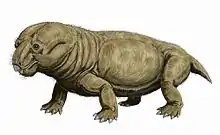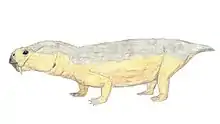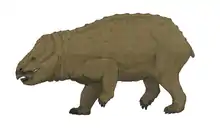Rastodon
Rastodon is an extinct genus of anomodonts. It is the oldest and most basal known genus of bidentalian dicynodonts. Uniquely among dicynodonts, its tusks curve forward.[1] The type and only species is R. procurvidens.
| Rastodon | |
|---|---|
| Scientific classification | |
| Kingdom: | Animalia |
| Phylum: | Chordata |
| Clade: | Therapsida |
| Clade: | †Dicynodontia |
| Clade: | †Bidentalia |
| Genus: | †Rastodon Boos et al. 2016 |
| Species | |
| |
Etymology
Rastodon is derived from the Rio do Rasto Formation, where its remains were found, and the Greek word for "tooth". The species name, R. procurvidens, means "curved forward tooth" and describes its uniquely shaped teeth.
Provenance
Only a single specimen of Rastodon has been discovered so far. It comes from the Rio do Rasto Formation, of the Guadalupian of Brazil.
Description
Rastodon is a fairly typical dicynodont. It bore a beaked head with a single pair of tusks and a keratin-covered nasal boss. However, it does possess several distinctive traits, of which its anteriorly-curved tusks are the most distinctive. Furthermore, its skull is relatively long and shallow compared to its close relatives. Its tusks contacted the lower jaw during propalinal mastication.
Classification
Rastodon is most parsimoniously placed as the basalmost bidental dicynodont, although it may be slightly more derived within Bidentalia.
See also
- List of synapsids
References
- Boos, Alessandra D. S.; Kammerer, Christian F.; Schultz, Cesar L.; Soares, Marina B.; Ilha, Ana L. R. (2016). "A new dicynodont (Therapsida: Anomodontia) from the Permian of southern Brazil and its implications for bidentalian origins". PLoS ONE. 11 (5): e0155000. doi:10.1371/journal.pone.0155000. PMC 4880204. PMID 27224287.





